Back betting, lay betting, back to lay, lay to back – these terms may seem daunting to newcomers in the realm of sports betting and football trading. If you find yourself perplexed by their meanings, fear not.
In this article, I aim to demystify the concepts of lay betting and back betting, providing you with a comprehensive guide to understand and utilise these fundamental techniques.
By mastering the principles of back and lay betting, you’ll be primed to embark on your sports trading journey with confidence, potentially unlocking profitable opportunities in football and other sports markets.
Below I will answer the following and more:-
- What is back betting?
- What is lay betting?
- What does lay to back mean?
- What does back to lay mean?
- What is your liability when you do a lay bet?
- Understanding odds movements
- How to do a back to lay trade
- How to do a lay to back trade
- The lay the draw strategy
Let’s take a look.
What is back betting?
If you have ever opened the Betfair Exchange website you will notice that you have two options which is to back a selection or lay a selection.
To back a selection simply means to bet on the event happening.
Below I give you a couple of examples, first is a Champions League match between PSG and Barcelona, and the second is a horse race from Market Rasen.
Let’s look at the footy first.
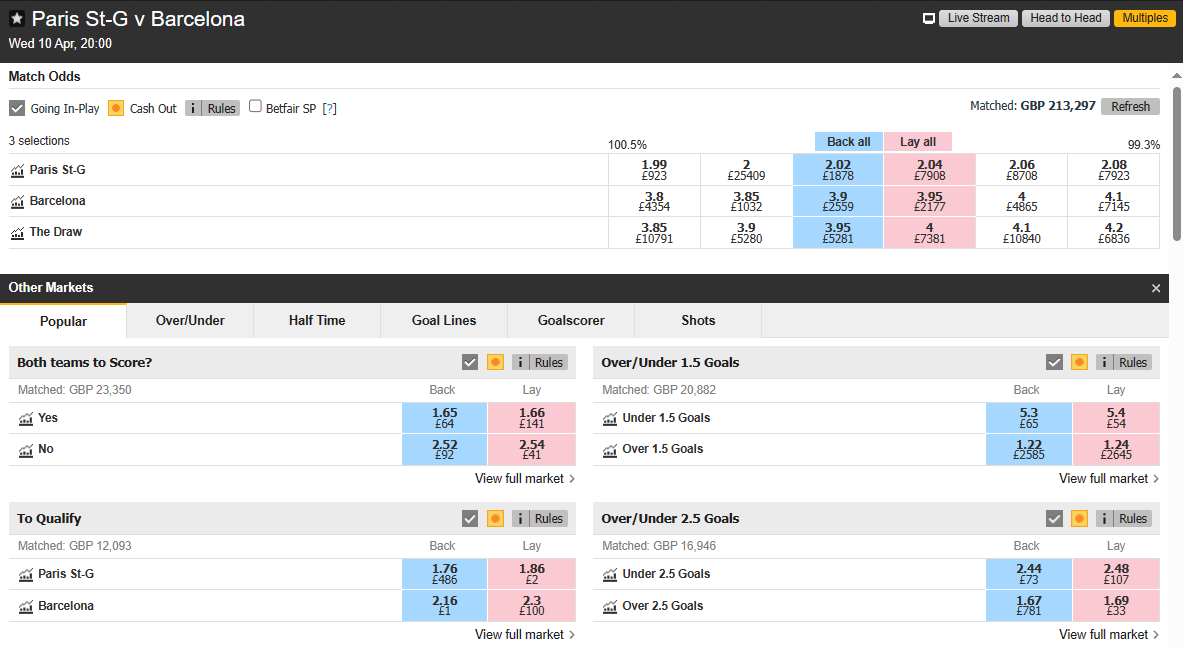
The blue columns are to back a selection with the pink columns to lay the selection.
In the above example, there are multiple markets. Match Odds are the home win, draw, or away win markets. We also have the Both Teams to Score, Over/Under 1.5 goals, Over/Under 2.5 goals, and the To Qualify market.
Let’s say that I fancy Barcelona to win the match. If I wanted to place a £10 bet on them, I would simply click the blue column box opposite Barcelona, enter my £10 stake, and click “Place bets”.
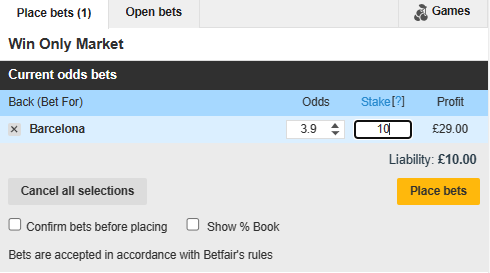
You will then see the potential risk and reward displayed with these also displayed under each selection which you can see below.

You can see that both prior to placing the bet and afterwards, the system will show you your potential profit and loss. So if PSG win you will lose £10, if the match is a draw you will lose £10, but if Barcelona win, you will win £29.
This is the odds (3.9) x £10 which is £39 minus your original stake (£10) which gives you a profit of £29.
Your liability is the maximum amount that you will lose if you get it wrong and let your bet run to the end of the match.
With traditional bookmakers, we can only back a selection, however, with Betfair, we can become the bookmakers and lay a selection as well.
When we say “lay a selection” it means to bet against the event happening.
So let’s go back to our example above. Let’s say I have changed my mind and I am not sure on who will win or lose the match but I am confident that it will not be a draw. What I can do now is lay the draw, which is to bet against the draw happening.
What I would do now is to click on the pink box next to the draw as I want to “lay the outcome” or bet against it happening.

Once you click on that box, you can now enter your stake.
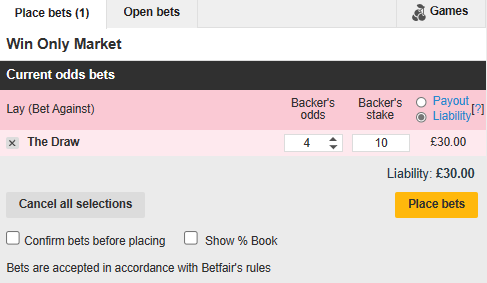
However, this time your liability has changed from the previous £10 to £30!
But why is this?
This is because you are now laying the outcome which in our case is the draw, at odds of 4.0.
£10 x 4.0 – £10 (your stake) = £30.
Your liability is now £30 as you have offered another trader/bettor on Betfair odds of 4.0 (3/1 in fractional odds).
- For every back bet, there has to be someone on the other side wishing to lay it at that price.
- For every lay bet, there has to be someone on the other side wishing to back it at that price.
Our potential profit and liability are now shown on the other side under each potential outcome.
£10 profit if PSG or Barcelona win, but a loss of £30 if the match ends in a draw.

The same thing applies to the other markets for a football match as well.
Let’s have a look at a horse race – the 4 pm at Market Rasen.
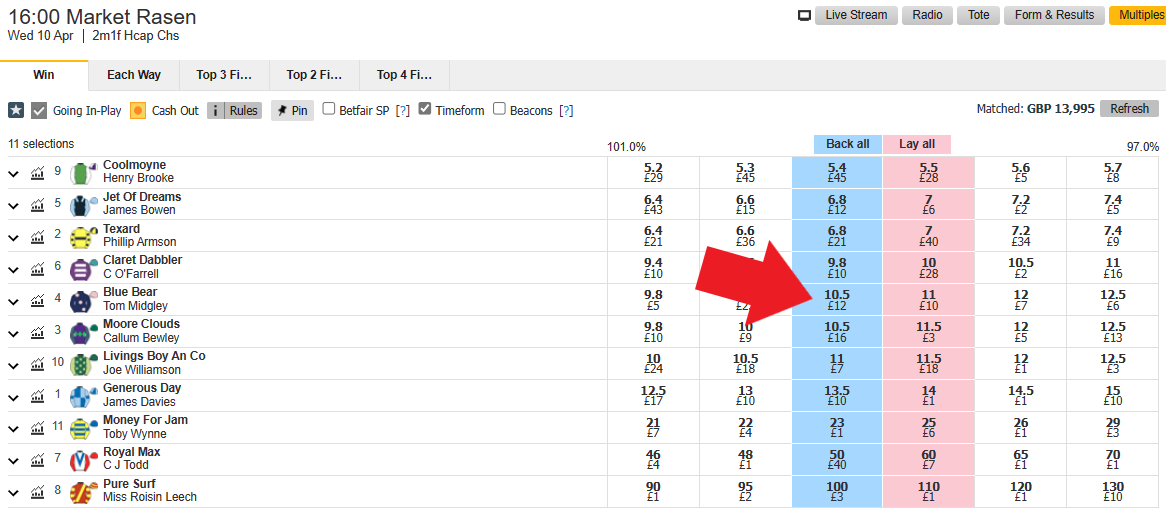
If I think Blue Bear will win, I can place a £10 bet on it by clicking the blue box with 10.5 in it which is its current odds to win.
When I do, I see the following where I can enter my stake.
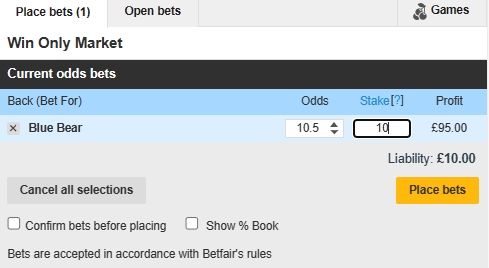
You can see that my potential profit is £95. This is £10 (my stake) x 10.5 – £10.
My liability of course is £10 as I am backing Blue Bear to win and not laying it.
When using decimal odds you always remove your stake from the total. When using traditional fractional odds, your stake is added on top.
What is lay betting?
So what happens if I want to place a lay bet on Blue Bear as I don’t think it has a hope in hell of winning?
I would click on the pink box to lay next to Blue Bear and then enter my £10 stake.
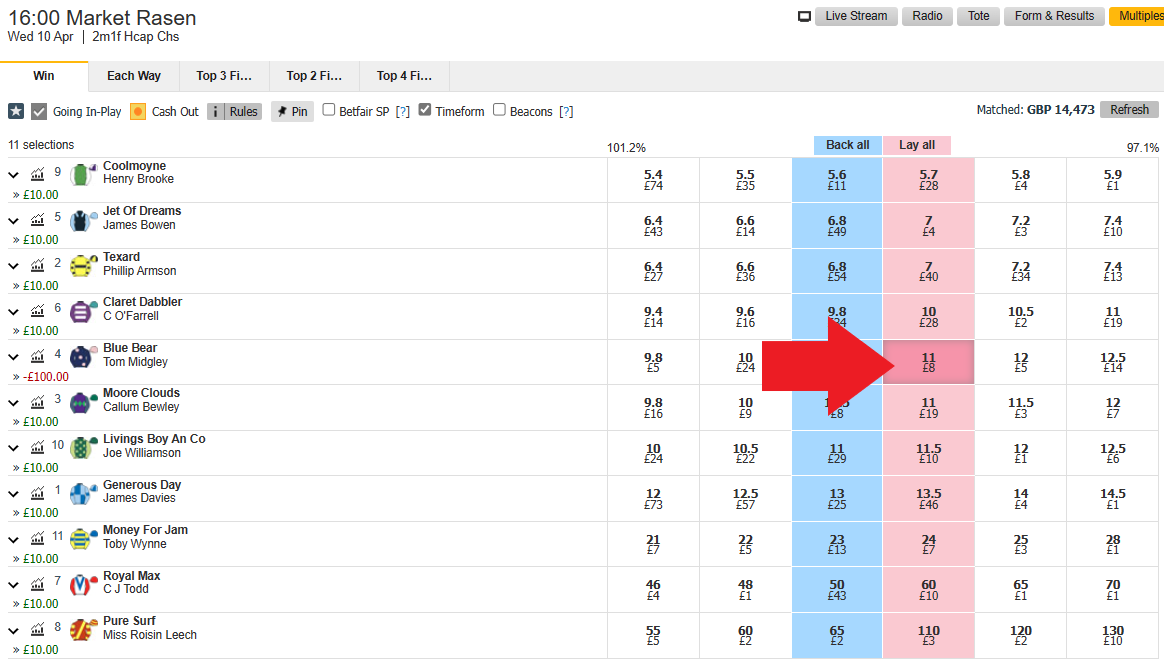
You can see my potential profit and loss below AND in the shot above next to all of the horses and how much I would make or lose depending on which horse won the race.
Notice how if Blue Bear wins I will now LOSE £100, but if any of the other horses wins, I will win my lay stake of £10.
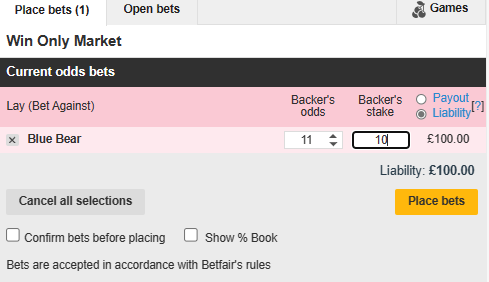
The difference between the back price and the lay price is the ‘spread’.
So in Blue Bear’s example, the back price is 10.5, but the lay price is 11.0, a 0.5 tick spread.
Depending on the odds, this can be a spread of 0.1, 0.01, 0.02, 0.5, 1.0, or 5.0 for example. I won’t go into detail on these spreads which are also referred to as ‘tick intervals’ but just know that they vary depending on the odds of the selection.
What does back to lay mean?
When we say “back to lay” we mean to back a selection in order to lay it at a lower price.
In trading, you will often hear the expression “back high, lay low” or “lay low, back high”.
By doing either of these it means we can lock in a profit based on the movement on the odds in our favour.
Take a look at the example below.
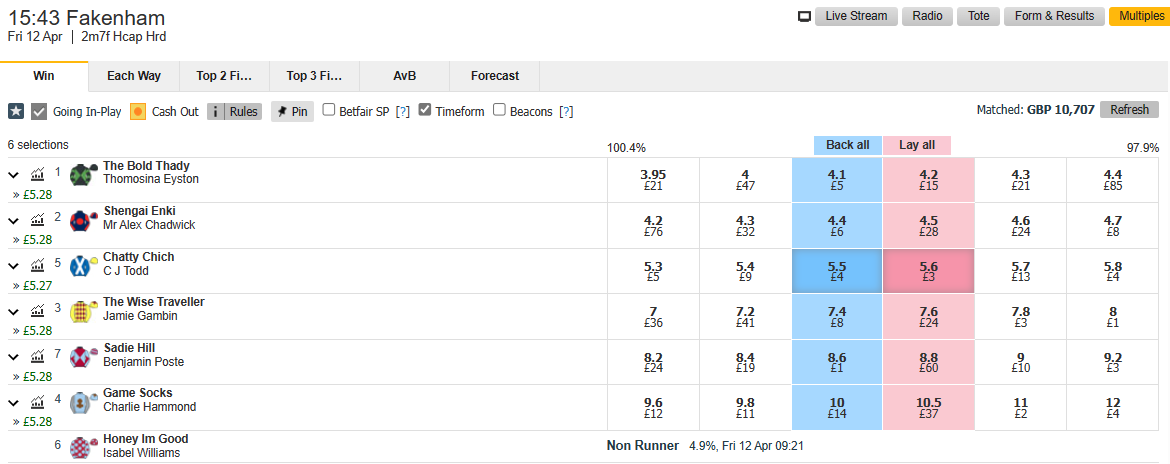
This is a race from Fakenham.
Let’s say that I have done my research, and I can see that Chatty Chich doesn’t win many races but always runs well. This means that more often than not, its odds drop in-running or ‘contract’.
Below you can see that if I back the horse Chatty Chich before the race for £10 at 5.5, I can then lay it pre-race or in-running at 3.6 for 15.28.
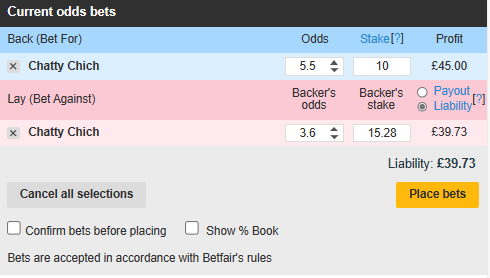
If during the race my horse runs well and its odds drop to 3.6, my lay bet will get matched.
You can see below that this would result in a profit of £5.28 no matter what happens and regardless of whether the horse wins or loses.
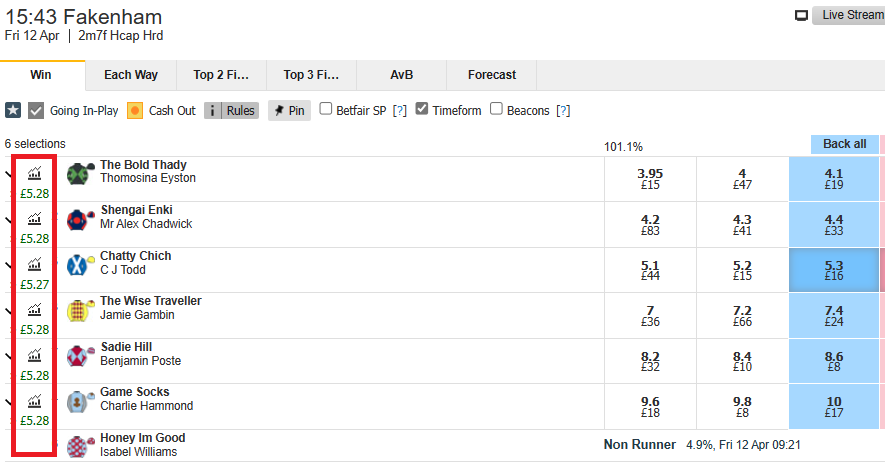
If Chatty Chich doesn’t run well, and its odds do not reach the desired 3.6, I will lose my £10 back stake.
Below you can see an alternative calculation using a back/lay betting calculator.
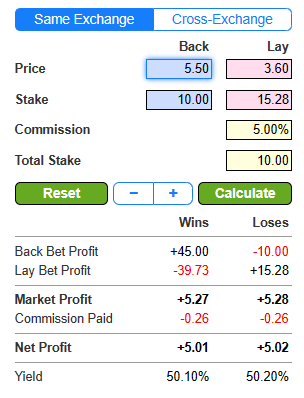
Note that the profit is slightly less as the calculator takes into account the 5% commission charged by Betfair on all winning bets.
So a 50% profit and the horse doesn’t even need to win! Not bad eh?
Of course you can juggle the odds and win more or less. It’s up to you.
You may find that the horse’s odds regularly drop around 25%, in which case you can adjust accordingly to give yourself a smaller profit. The bonus is that the horse doesn’t need to run as well as it would have to do if you were looking to win 50% of your stake as the lay odds won’t have to fall so much.
Back to lay and lay to back are popular methods of trading on Betfair as you don’t necessarily have to be right in terms of the final outcome, just that the odds move sufficiently in your favour.
What does lay to back mean?
As you may have already gathered, lay to back is the complete opposite of back to lay.
So you would lay a selection first with the view that the odds will drift out. If they do, you can back the selection to lock in a profit.
Let’s say I want to lay Chatty Chich for £10. Its odds have now changed to 5.1 to lay.
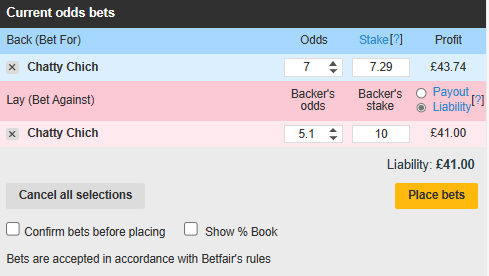
Above you can see that I placed my lay stake for £10 at 5.1, giving me a liability of £41.
I can then back it at 7 for £7.29 and lock in a lovely profit of £2.71.
This is of course only if the price drifts and my back bet gets backed by another trader.
If I lay Chatty Chich, and he runs well and wins, the back price may never reach 7 which will mean that I would lose my liability which would be £41.
You can see the shot below showing my potential profit if my back bet gets matched.
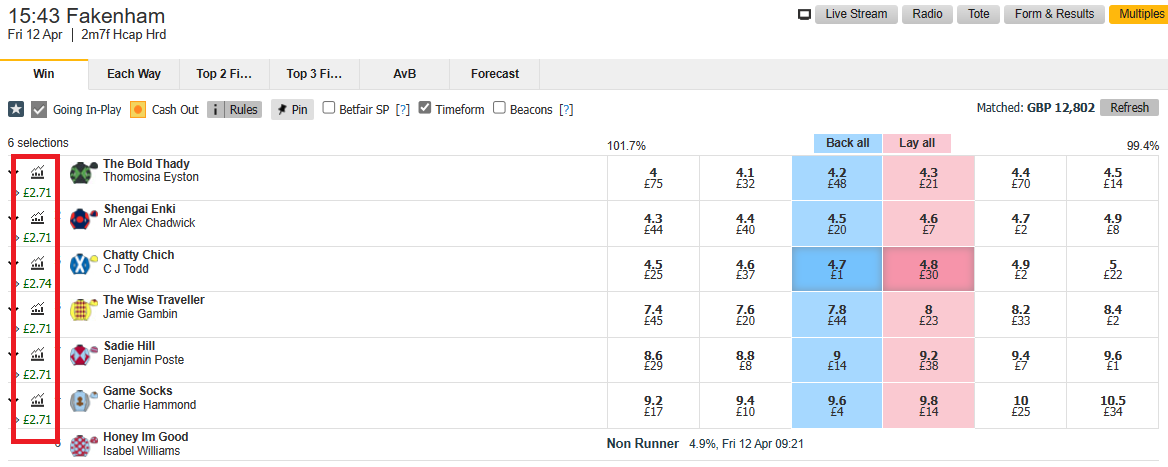
So whether you are backing to lay or laying to back, the odds need to move in the right direction so your opposite back or lay bet gets matched.
There are similarities in the above with stock trading. Betfair is an exchange after all, however, we are not trading shares, we are trading odds.
If I like Apple’s shares and I feel they will go up in the near future, I will buy them with the view to selling them for a profit when they reach a certain point. However, if I buy Apple and the share price drops, I will now be in a losing position. I can then either sell them for a loss, or wait for them to rise again so that I am back in profit.
Lay the draw trading strategy
One of the most common lay betting strategies in football is to lay the draw. I touched on this briefly further up in the match between PSG and Barcelona.
As mentioned, if you feel a match will not end in a draw, you could lay it and then lock in a profit when the favourite goes in front or if one of the teams goes two goals up.
There are lots of ways of trading lay the draw including laying the draw in the first half, laying the draw in the second half, or full match lay the draw.
I employ my own lay the draw strategy called LTD2. You can find out more here.
So there you go. Everything you need to know about back and lay betting on Betfair.
All the best with your trading!


